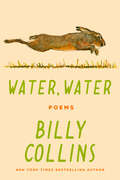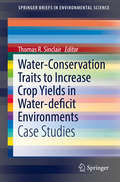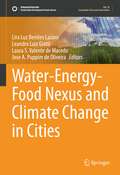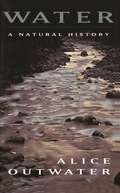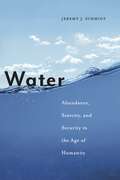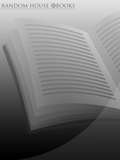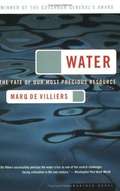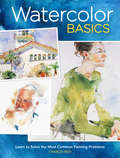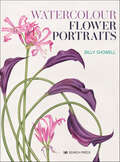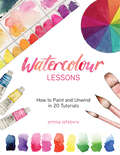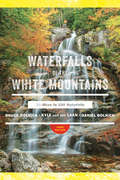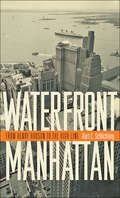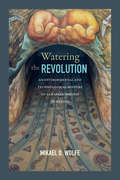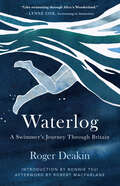- Table View
- List View
Water, Water: Poems
by Billy CollinsFrom the former Poet Laureate of the United States and New York Times bestselling author of Aimless Love comes a wondrous new collection of poems focused on the joys and mysteries of daily life.&“Among the best poems that [Billy] Collins has ever written.&”—Maureen Corrigan, NPR&“Witty, wry and tender when it hurts, Water, Water is a pleasure to read and easy to give.&”—The Washington Post&“Collins remains the most companionable of poetic companions.&”—The New York TimesIn this collection of sixty new poems, Billy Collins writes about the beauties and ironies of everyday experience. A poem is best, he feels, when it begins in clarity but ends with a whiff of mystery. In Water, Water, Collins combines his vigilant attention and respect for the peripheral to create moments of delight. Common and uncommon events are captured here with equal fascination, be it a cat leaning to drink from a swimming pool, a nurse calling a name in a waiting room, or an astronaut reciting Emily Dickinson from outer space. With his trademark lyrical informality, Collins asks us to slow down and glimpse the elevated in the ordinary, the odd in the familiar. It&’s no surprise that The New York Times and The Wall Street Journal both call Collins one of America&’s favorite poets.The Monet ConundrumIs every one of these poemsdifferent from the othershe asked himself,as the rain quieted down,or are they all the same poem,haystack after haystackat different times of day,different shadows and shades of hay?
Water-Associated Infectious Diseases
by Shailendra K. SaxenaThis book provides a comprehensive overview of the different water-associated infectious diseases and their linked pathogens with plausible strategies for their mitigation. Although, we are in the era of 21st century having most of the advanced technologies at hand, yet water-associated infectious diseases are the major contributors towards the worldwide morbidity and mortality. The book also focuses on the various implementation strategies of sustainable hygienic conditions, discusses the robust, and reliable policies and strategies on a global aspect to provide unprivileged people access to the basic sanitation, hygiene and water. In addition, the book discusses the possible indirect effect of global warming on the spread of infectious diseases through the distribution of associated vectors.
Water-Carbon Dynamics in Eastern Siberia (Ecological Studies #236)
by Tetsuya Hiyama Takeshi Ohta Yoshihiro Iijima Ayumi Kotani Trofim C. MaximovThis book discusses the water and carbon cycle system in the permafrost region of eastern Siberia, Providing vitalin sights into how climate change has affected the permafrost environment in recent decades. It analyzes the relationships between precipitation and evapotranspiration, gross primary production and runoff in the permafrost regions, which differ from those intropical and temperate forests. Eastern Siberia is located in the easternmost part of the Eurasian continent, and the land surface with underlying permafrost has developed over a period of seventy thousand years. The permafrost ecosystem has specific hydrological and meteorological characteristics in terms of the water and carbon dynamics, and the current global warming and resulting changes in the permafrost environment are serious issues in the high-latitude regions. The book is a valuable resource for students, researchers and professionals interested in forest meteorology and hydrology, forest ecology, and boreal vegetation, as well as the impact of climate change and water-carbon cycles in permafrost and non-permafrost regions.
Water-Conservation Traits to Increase Crop Yields in Water-deficit Environments
by Thomas R. SinclairThis volume explores specific approaches that have shown to result in crop yield increases. Research on the physiological understanding of these methods has led to the development of practical applications of plant breeding approaches to genetically improve crops to achieve higher yields. Authoritative entries from crop scientists shed new light on two water-conservation traits: one that is based on an initiation of the decrease in transpiration earlier in the soil drying cycle, and the second that is based on a sensitivity of transpiration rate under high atmospheric vapor pressure deficit that results in partial stomatal closure. Both these approaches involve partial stomatal closure under well-defined situations to decrease the rate of soil water loss. Readers will be able to analyze the circumstances under which a benefit is achieved as a result of the water-limitation trait; and key discussion points in the case studies presented will help answer questions such as what species, which environments, how often will yield be benefited for various crop species? Contributions also review the genetic variation for these two traits within each crop species and the physiological basis for the expression of these traits.
Water-Energy-Food Nexus and Climate Change in Cities (Sustainable Development Goals Series)
by Jose A. Puppim de Oliveira Leandro Luiz Giatti Lira Luz Benites Lazaro Laura S. Valente de MacedoThis book aims to contribute to the transdisciplinary study of the water-energy-food (WEF) nexus in cities and to help policy makers adopt a more integrated approach to natural resources management in urban environments to face the challenges and threats of climate change. This approach is based on a multidimensional scientific framework that seeks to understand the complex and non-linear interrelationships and interdependencies between water-energy-food under climate change and to generate solutions to reduce trade-offs among development goals and generate co-benefits that help encourage sustainable development and contribute to the achievement of SDGs, mainly SDG 11 (make cities and human settlements inclusive, safe, resilient and sustainable) and SDG 13 (take urgent action to combat climate change and its impacts).Governing the WEF nexus in cities is one of the greatest resource challenges of our time, as cities consume large amounts of WEF, but one that can also generate relevant alternatives with which to tackle climate change. To help fostering these alternatives, this book analyzes the governance, institutional and political economy factors that determine the effectiveness of the nexus approach and reviews the potential, the benefits and the policy implications of the adoption of the WEF nexus approach at the urban level. Through a series of hands-on cases, chapters in this book present the opportunities of the WEF nexus approach to achieve innovation and transformative change and discuss concrete areas of synergy and policy initiative to raise urban resilience. Water-Energy-Food Nexus and Climate Change in Cities will serve both as a guide for policy makers as well as a useful resource for students and researchers in fields such as urban studies, public health, environmental sciences, energy studies and public policy interested in learning how cities can represent possibilities to navigate and manage sustainability from local to global.
Water: 100 Energy-Saving Tips for the Home
by Jon Clift Amanda Cuthbert100 simple and effective tips for saving water, inside and outdoors of your home or business. Packed with practical ideas for your kitchen, bath, landscaping, and water using chores.
Water: A Biography
by Giulio BoccalettiSpanning millennia and continents, here is a stunningly revealing history of how the distribution of water has shaped human civilization. Boccaletti, of The Nature Conservancy, &“tackles the most important story of our time: our relationship with water in a world of looming scarcity&” (Kelly McEvers, NPR Host). Writing with authority and brio, Giulio Boccaletti—honorary research associate at the Smith School of Enterprise and the Environment, University of Oxford—shrewdly combines environmental and social history, beginning with the earliest civilizations of sedentary farmers on the banks of the Nile, the Tigris, and the Euphrates Rivers. Even as he describes how these societies were made possible by sea-level changes from the last glacial melt, he incisively examines how this type of farming led to irrigation and multiple cropping, which, in turn, led to a population explosion and labor specialization. We see with clarity how irrigation&’s structure informed social structure (inventions such as the calendar sprung from agricultural necessity); how in ancient Greece, the communal ownership of wells laid the groundwork for democracy; how the Greek and Roman experiences with water security resulted in systems of taxation; and how the modern world as we know it began with a legal framework for the development of water infrastructure. Extraordinary for its monumental scope and piercing insightfulness, Water: A Biography richly enlarges our understanding of our relationship to—and fundamental reliance on—the most elemental substance on earth.
Water: A Natural History
by Alice OutwaterAn environmental engineer turned ecology writer relates the history of our waterways and her own growing understanding of why our waterways continue to be polluted#151;and what needs to be done to save this essential natural resourse. Water: A Natural History takes us back to the diaries of the first Western explorers; it moves from the reservoir to the modern toliet, from the grasslands of the Midwest to the Everglades of Florida, throught the guts of a wastewater treatment plant and out to the waterways again. It shows how human-engineered dams, canals and farms replaces nature’s beaver dams, prairie dog tunnels, and buffalo wallows. Step by step, Outwater makes clear what should have always been obvious: while engineering can depollute water, only ecologically interacting systems can create healthy waterways. Important reading for students of environmental studies, the heart of this history is a vision of our land and waterways as they once were, and a plan that can restore them to their former glory: a land of living streams, public lands with hundreds of millions of beaver-built wetlands, prairie dog towns that increase the amount of rainfall that percolates to the groundwater, and forests that feed their fallen trees to the sea.
Water: Abundance, Scarcity, and Security in the Age of Humanity (Global Challenges In Water Governance Ser.)
by Jeremy J. SchmidtAn intellectual history of America's water management philosophyHumans take more than their geological share of water, but they do not benefit from it equally. This imbalance has created an era of intense water scarcity that affects the security of individuals, states, and the global economy. For many, this brazen water grab and the social inequalities it produces reflect the lack of a coherent philosophy connecting people to the planet. Challenging this view, Jeremy Schmidt shows how water was made a “resource” that linked geology, politics, and culture to American institutions. Understanding the global spread and evolution of this philosophy is now key to addressing inequalities that exist on a geological scale. Water: Abundance, Scarcity, and Security in the Age of Humanity details the remarkable intellectual history of America’s water management philosophy. It shows how this philosophy shaped early twentieth-century conservation in the United States, influenced American international development programs, and ultimately shaped programs of global governance that today connect water resources to the Earth system. Schmidt demonstrates how the ways we think about water reflect specific public and societal values, and illuminates the process by which the American approach to water management came to dominate the global conversation about water. Debates over how human impacts on the planet are connected to a new geological epoch—the Anthropocene—tend to focus on either the social causes of environmental crises or scientific assessments of the Earth system. Schmidt shows how, when it comes to water, the two are one and the same. The very way we think about managing water resources validates putting ever more water to use for some human purposes at the expense of others.
Water: Healer or Poison?
by Jan de VriesWater is one of the basic necessities of life - no organism can survive in its absence. In recent years, however, it has become increasingly clear that our public water supply is not as pure as it should be and many are questioning its high chemical content. 'Water scares' are becoming all too frequent. Beaches, seas and oceans themselves are being increasingly contaminated. Plankton are beginning to die and the Earth is being deprived of one of its primary sources of oxygen. In this important addition to his Nature's Gift series, Jan de Vries discusses the implications of this self-inflicted damage and points out the health risks of the various forms of water contamination. Yet, in its pure form, water is one of nature's greatest healers and this volume draws on Jan de Vries' extensive experience of the various water-treatment methods. It provides his readers with guidance and sensible advice on the benefits to be gained from pure, unadulterated water, and it's safe use. Anyone who has been perturbed or confused by the conflicting reports and guidelines concerning this important issue will welcome such an informative book.
Water: The Fate of Our Most Precious Resource
by Marq De VilliersIn his award-winning book WATER, Marq de Villiers provides an eye-opening account of how we are using, misusing, and abusing our planet's most vital resource. Encompassing ecological, historical, and cultural perspectives, de Villiers reports from hot spots as diverse as China, Las Vegas, and the Middle East, where swelling populations and unchecked development have stressed fresh water supplies nearly beyond remedy. Political struggles for control of water rage around the globe, and rampant pollution daily poses dire ecological theats. With one eye on these looming crises and the other on the history of our dependence on our planet's most precious commodity, de Villiers has crafted a powerful narrative about the lifeblood of civilizations that will be "a wake-up call for concerned citizens, environmentalists, policymakers, and water drinkers everywhere" (Publishers Weekly).
Water: The Fate of Our Most Precious Resource
by Mauq De VilliersOverview of past, present, and potential future problems endangering the world's water supply. Index and Notes not included.
Water: The International Crisis
by Robin ClarkeOnly 3 per cent of the world's water is freshwater and about one third of that is inaccessible. The rest is very unevenly distributed, parts of Canada and the Amazon, for example are both more than amply suppied. Terrible and permanent water stress can be seen, among other places, in the drylands of Africa caused not just by drought, but by poverty leading to poor land management and over-population.;As with so many other things, those most badly affected are the poor nations of the world who are frequently faced with an impossible dilemma: they must either limit their water use to decreasingly available unused water or they must make do with used but untreated and, therefore, dangerous water. They cannot afford the technology to recycle safely. In rural regions increased populations and frequent droughts mean that in addition to the lack of fresh, clean water for human consumption there are inadequate supplies for crop irrigation.;An enormous proportion of the world's population lives in countries which share their primary sources of water with other nations, for example 12 countries depend on the Danube, 10 on the Niger, 9 on the Nile. Water is essential to development, both in poor countries and in rich, the use made of a major river in one country can affect seriously the possibilities open to another. Hence the international shortage is a major threat to world security. To take but one example, if Turkey goes ahead with its plan to damn the Euphrates, then Iraq and Syria, already water-stressed countries could be in even more serious trouble - they are hardly likely to accept the situation.;This book describes the world situation, addresses the nature of the problems, shows the ways in which they have been shamefully neglected in all development and economic thinking and proposes some solutions, often simple and well-tried but which could ensure water security for the whole world.
Watercolor Basics: Learn To Solve The Most Common Painting Problems
by Charles ReidProblem Solved! Expert fixes for not-quite-right watercolors.As one of today's most sought-after workshop instructors, Charles Reid knows the most common stumbling blocks faced by artists and the best ways to overcome them. With expert advice on everything from drawing and design to fine-tuning figure and landscape paintings, Charles Reid's Watercolor Solutions will help you identify shortcomings in your paintings, fix recurring problems, and become a better watercolorist-no matter what your skill level.Inside, you'll find masterful insights from one of North Light's best-selling authors: • Advice for successful color mixing, tips to avoid overworking and other straightforward information you can take straight to your easel • 10 step-by-step demonstrations make the lessons easy to understand and implement • Student work with critiques that call out strengths, weaknesses and tips on how the paintings can be improved Whether your portraits feel contrived, your landscapes lack depth, or your colors look unnatural, this book holds the secrets to stronger, looser and livelier paintings.
Watercolor: From Concept to Finished Painting (Dover Art Instruction)
by Tony CouchA complete watercolor instruction guide, this long-time bestseller is full of vibrant illustrations, examples of what to do and what to avoid, and tips that make the medium accessible. Written by a true master, it presents practical information on the basics of setting up a good painting — composition, color, and light — before discussing the medium's advantages and concluding with informative demonstrations.Tony Couch emphasizes practice as the key to developing watercolor skills. Starting with equipment choices and methods for controlling paint on wet paper, he proceeds to discussions and illustrations of the elements and principles of design. Other topics include working with color and value, pulling together a composition, and acquiring techniques for handling watercolor. Easy-to-follow examples chart the progress from a rough sketch into a finished painting. Watercolor: You Can Do It! is an ideal companion for beginning to advanced artists, suitable for individual study as well as a text for art students and teachers.
Watercolor: Paint Cute Animals and Wildlife in 12 Easy Lessons
by Natalia SkatulaLearn how to paint adorable animals, flavorful fruits, lively plants, and more in this free-and-easy approach to watercolor. Artist Natalia Skatula has a beautiful, whimsical style that will charm you through twelve simple step-by-step projects and over one hundred worked examples. Beginning with an overview of materials and equipment, Natalia then covers the general techniques needed to achieve the paintings, along with her top-ten personal tips for success. Projects include: A majestic whale An adorable sloth Elephants Pandas Dogs Llamas Bears Foxes Rabbits And more Watercolor Wild and Free also includes a range of presentation ideas to inspire you to put your finished work on display or gift it. The gallery of examples that follows includes plants, cats, beetles, birds, sealife, jungle creatures and fruits, giving you a treasure-trove of references for your painting. This book also makes the perfect gift for artists of all ages, especially plant and animal lovers. Find the inspiration and technique to start your watercoloring adventures with this beautiful guide!
Watercolour Flower Portraits
by Billy Showell"The book is packed with step-by-step guides on drawing and painting techniques, colour mixing and clever compositions, it is an invaluable source of ideas for anyone wanting to develop their flower painting skills." – SAABilly Showell's exquisite and technically brilliant watercolour flower portraits are beautifully presented in this highly informative, lavishly illustrated book. First published in 2009 and now back by popular demand in paperback, it provides the reader with valuable information on the brushes, paints, paper and other equipment they need, together with detailed guidance on drawing and painting techniques, colour mixing and composition. Learn how to paint white flowers, leaves and stems; add shadows; and create stamen, carpels, veins and texture. The book finishes with four stunning step-by-step projects to practice and consolidate your newly-acquired skills. This is an invaluable source of information and inspiration for anyone who wants to develop their flower painting skills.
Watercolour Lessons: How to Paint and Unwind in 20 Tutorials
by Emma LefebvreA Watercolour How-To Book for the Whimsical Creative"I am brand new to watercolor and this book is exactly what I needed. Highly recommended." —Amazon review#1 Bestseller in Watercolor Painting, Plants & Animals, Mixed Media & DecoratingTake a walk down the path of translucent pastels and delicate wet washes with Watercolour Lessons. Filled with engaging exercises, this vibrant guide contains step-by-step instructions on how to paint with watercolours. For beginners and those looking to improve their technique, Watercolour Lessons brings artistic inspiration to any home.A watercolour guide book that is uniquely you. Follow author and artist Emma Lefebvre as she teaches the fundamentals of this simple-to-use painting medium. With an emphasis on developing skills and style, Watercolour Lessons offers the necessary tools to produce paintings anyone would be proud to display, gift, or to keep for themselves.Learn how to paint with watercolours. For beginners and mavens alike, Watercolour Lessons offers straight-forward lessons to help anyone develop their craft and unique artistic style. From color theory to tool sets, it explores watercolour basics while helping painters—old and new—gain confidence in themselves and their work.Inside, you’ll find:A list of essential watercolour tools and how to use themAn easy-to-understand explanation of watercolour techniques and theoriesCharmingly simple watercolor painting projects with step-by-step instructionsNotes on common mistakes and how to fix themIf you’re looking for creative art therapy exercises, want to learn how to paint with watercolors for beginners or intermediate artists, or enjoy books such as Watercolor the Easy Way Flowers, Watercolor Workbook, Watercolor With Me in the Forest, or Everyday Watercolor, you’ll love Watercolour Lessons.
Waterfalls and Wildflowers in the Southern Appalachians
by Timothy P. SpiraIf you love waterfalls, here are some of the best hikes in the Southern Appalachians. And if you love plants--or simply would like to learn more about them--you will be in hiking heaven: naturalist Tim Spira's guidebook links waterfalls and wildflowers in a spectacularly beautiful region famous for both. Leading you to gorgeous waterfalls in Virginia, North Carolina, Tennessee, South Carolina, and Georgia, the book includes many hikes in the Great Smoky Mountains National Park and along the Blue Ridge Parkway. As he surveys one of America's most biologically diverse regions, Spira introduces hikers to the "natural communities" approach for identifying and understanding plants within the context of the habitats they occupy--equipping hikers to see and interpret landscapes in a new way.Each of the 30 hikes includes: * a detailed map and GPS coordinates* a lively trail description highlighting the plants you are most likely to see, as well as birds and other animals along the way* an associated plant species listAlso featured:* beautiful color photographs of 30 destination waterfalls, 125 plants, and more* detailed descriptions of 125 key plant species* 22 drawings to help identify plant structures* a glossary of botanical terms
Waterfalls of the Blue Ridge: A Hiking Guide to the Cascades of the Blue Ridge Mountains
by Johnny Molloy Nichole Blouin Marilou Weir Bordonaro Steve BordonaroWaterfalls of the Blue Ridge, now in its 4th edition, combines the pleasure of hiking with the wonder of one of nature's most captivating sights: waterfalls. <P><P>Outlining hikes that feature more than 110 waterfalls in the Blue Ridge Mountains, this guide has been updated with 30 new waterfalls, updates to existing routes, and new photos. Offering something for hikers of every level of experience, waterfalls range in height from 10 to 500 feet, some requiring no hike at all while others include hikes of up to 10 miles. In this guide, today's most experienced guidebook author Johnny Molloy teams up with Nicole Blouin and Marilou & Steve Bordonaro to introduce hikers to waterfalls spanning 2 states, 4 national forests, 3 national parks, and 8 state parks all throughout the Blue Ridge.
Waterfalls of the White Mountains (3rd Edition): 30 Hikes To 100 Waterfalls
by Bruce R. Bolnick Daniel Bolnick Kyle van der LaanExplore the scenic splendor of the White Mountains of New Hampshire with this guide to the Region’s Waterfalls The White Mountains of New Hampshire are home to many gushing, cascading waterfalls waiting to be discovered. This completely revised and updated edition of Waterfalls of the White Mountains outlines hiking trails ideal for observing the more than 100 waterfalls in the region, no matter experience level or ability. Each hike opens with the trail at a glance overview—including the distance, difficulty, altitude gain, and directions to the starting point. Helpful tips and suggestions are offered throughout, like the best times of year for each hike, best vantage points for viewing the falls, great swimming holes for cooling down, and uncrowded scenic treasures that are perfect for a woodland picnic. Also featuring labeled maps and fascinating short essays on local history and lore, Waterfalls of the White Mountains guides readers through their next excursion to the White Mountains of New Hampshire.
Waterfalls, Glaciers, and Avalanches (Rigby PM Plus Non Fiction Ruby (Levels 27-28), Fountas & Pinnell Select Collections Grade 3 Level Q)
by Jan AndersonThis text focuses upon the movement and flow of water, ice and snow, and how this affects the environment and the lifestyles of the people who live there. Text forms include a labelled diagram, a diary excerpt and a newspaper report.
Waterfront Manhattan: From Henry Hudson to the High Line
by Kurt C. SchlichtingThe waterfront was the key to New York City’s growth and prosperity.For hundreds of years, the shorefront of Manhattan Island served as the country’s center of trade, shipping, and commerce. With its maritime links across the oceans, along the Atlantic coast, and inland to the Midwest and New England, Manhattan became a global city and home to the world’s busiest port. It was a world of docks, ships, tugboats, and ferries, filled with cargo and freight, a place where millions of immigrants entered the Promised Land. In Waterfront Manhattan, Kurt C. Schlichting tells the story of the Manhattan waterfront as a struggle between public and private control of New York’s priceless asset. Nature provided New York with a sheltered harbor but presented the city with a challenge: to find the necessary capital to build and expand the maritime infrastructure. From colonial times until after the Civil War, the city ceded control of the waterfront to private interests, excluding the public entirely and sparking a battle between shipping companies, the railroads, and ferries for access to the waterfront. In the second half of the nineteenth century, the City of New York regained control of the waterfront, but a whirlwind of forces beyond the control of either public or private interests—technological change in the form of the shipping container and the jet airplane—devastated the city’s maritime world. The city slowly and painfully recovered. Visionaries reimagined the waterfront, and today the island is almost completely surrounded by parkland, the world of piers and longshoremen gone, replaced by luxury housing and tourist attractions.Waterfront Manhattan is a wide-ranging history that will dazzle anyone who is fascinated by New York.
Watering the Revolution: An Environmental and Technological History of Agrarian Reform in Mexico
by Mikael D. WolfeIn Watering the Revolution Mikael D. Wolfe transforms our understanding of Mexican agrarian reform through an environmental and technological history of water management in the emblematic Laguna region. Drawing on extensive archival research in Mexico and the United States, Wolfe shows how during the long Mexican Revolution (1910-1940) engineers’ distribution of water paradoxically undermined land distribution. In so doing, he highlights the intrinsic tension engineers faced between the urgent need for water conservation and the imperative for development during the contentious modernization of the Laguna's existing flood irrigation method into one regulated by high dams, concrete-lined canals, and motorized groundwater pumps. This tension generally resolved in favor of development, which unintentionally diminished and contaminated the water supply while deepening existing rural social inequalities by dividing people into water haves and have-nots, regardless of their access to land. By uncovering the varied motivations behind the Mexican government’s decision to use invasive and damaging technologies despite knowing they were ecologically unsustainable, Wolfe tells a cautionary tale of the long-term consequences of short-sighted development policies.
Waterlog: A Swimmers Journey
by Roger Deakin“Like swimming through Alice’s Wonderland.” —Lynne Cox A swimming journey would give me access to that part of our world which, like darkness, mist, woods or high mountains, still retains most mystery. It would afford me a different perspective on the rest of land-locked humanity. A masterpiece of nature writing, Roger Deakin’s Waterlog is a fascinating and inspiring journey into the aquatic world that surrounds us. In an attempt to discover his island nation from a new perspective, Roger Deakin embarks from his home in Suffolk to swim Britain—the seas, rivers, lakes, ponds, pools, streams, lochs, moats, and quarries. Through the watery capillary network that braids itself throughout the country, Deakin immerses himself in the natural habitats of fish, amphibians, mammals, and birds. And as he navigates towns, private property, and sometimes dangerous waters and inclement weather, Deakin finds himself in precarious situations: he’s detained by bailiffs in Winchester, intercepted by the coast guard at the mouth of a river, and mistaken for a dead body on a beach. The result of this surprising journey is a deep dive into modern Britain, especially its wild places. With enchanting descriptions of natural landscapes, and a deep well of humanity, boundless humor, and unbridled joy, Deakin beckons us to wilder waters and inspires us to connect to the larger world in a most unexpected way. Thrilling, vivid, and lyrical, Waterlog is a fully immersive adventure—a remarkable personal quest, a bold assertion of the swimmer’s right to roam, and an unforgettable celebration of the magic of water.
